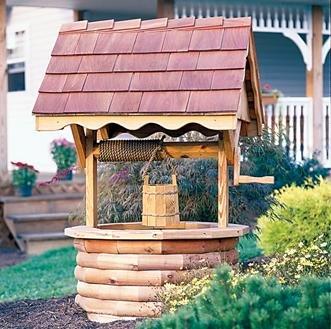Water of Life: Digging a well. Part I.
 If you are in a rural area or the outskirts of a small town, maybe in that town, you will have to drill a well for water. A local reputable source tells me that shallow wells of less than 100’ depth and springs are likely polluted from surface runoff, i.e.: fertilizer run off, agricultural spraying, chemical treated lawns-pastures-hayfields, cattle manure pit concentration, poor septic home systems, outdated small communal water treatment facilities, polluted reservoirs, logging, industrial wastes, meth labs, unauthorized dumping and landfills. Probably much more than we would want to know as this all leaches into the surface groundwater.
If you are in a rural area or the outskirts of a small town, maybe in that town, you will have to drill a well for water. A local reputable source tells me that shallow wells of less than 100’ depth and springs are likely polluted from surface runoff, i.e.: fertilizer run off, agricultural spraying, chemical treated lawns-pastures-hayfields, cattle manure pit concentration, poor septic home systems, outdated small communal water treatment facilities, polluted reservoirs, logging, industrial wastes, meth labs, unauthorized dumping and landfills. Probably much more than we would want to know as this all leaches into the surface groundwater.
I was also advised by a local lady who works in a water-testing laboratory to test ones water not only for the required E coli bacteria but also for a host of toxic minerals and chemicals.
For those living in the city area where you have re-cycled drinking water you are especially at risk for medicinal toxicity from anti-depressants and other pharmalogical concentrations wherein perhaps one half of the population is taking some prescribed drug and urinating it back into the system.
To protect ourselves there exists a myriad array of sanitizers, filters and “black lights” to choose from which we will discuss in Part II. The end result is of course drilling for a deeper well with its attendant costs. However there is more to drilling a water well than you think and to this end we are going to discuss some pitfalls and make suggestions for a better well water supply.
When we moved Back2theLand in 1983 one of our criteria for a rural farmstead was a spring. This told me that there was water available. However in the days of yore as a boy people were far and few and if you were out of a city pollution was relatively unknown. Today rural living is a growing suburbia with more and more people adding to the pollution. Springs are not safe from surface runoff. Also springs are subject to just quit on you and run dry. The spring box fills with roots and the old galvanized pipes are rusting out causing severe leaks. My springhouse, which I treasure dearly, is now a root cellar. The giant American Beech tree near by has spread its roots into the rock crevices, and with Beech trees the roots die in the core and make pipes to channel the water back to the tree. Hence you do not allow Beech trees near a spring. If this tree was not so old and a heritage tree, being one of the top eldest and biggest in the state I would have cut it down.
In 2002 we contacted several well diggers and calculated what they offered in services, materials, and costs. All varied. This is the rub. If you do not known what is going on, you can be shorted and gouged.
Although Floyd County boasts its water supply being endless there are some spots in this county that are bone dry no matter how far you dig. On my end of the county 200’ to 300’ is more than adequate to dig successful wells. On the other end of the county, maybe a 500’ well is necessary. Sometimes you can just drill a dry hole anywhere and you have to bear this cost. Considering that it averages, at the time of this writing, about $10.00 a foot this can get expensive. When I hear of a lady on the ridge drilling an 800’ well I ponder that she was scammed. Well drillers make money drilling and when they are drilling you have to be on site and check on the water coming up in the well shaft in gallons per minute. Ideally you want 7 gallons or more a minute, but this may not happen. In this area you can strike cave water, an underground water layer, or in my case 200’ below the valley floor for fossil water in clay beds. Different geological rock formations offer different possibilities but the bottom line is how much water is filling the drill hole at what rate.
I struck water at 165’ at 2 to 3 gallons a minute in the first of the rock fractures. As we went deeper more fractures were exposed and more water flow was gained. At 300’ I quit as that was for the history of deep wells in this area and in consultation with the driller I was at saturation point. Water then moved up the column of the drill hole to about 10’ from the top. This gave me a water column of about a gallon and a half per foot of pipe of 300-foot depth. That was my reservoir for domestic use- NOT watering the garden and fields. The pumps offered in Horse Power (HP) vary for the depth with a one horsepower 220Volt AC pump being about the maximum in use for domestic service. That limits the suction and push to a maximum of 300’ depth.
However at the bottom on the drill hole it is murky and you will have to raise the pump a few yards as sediment builds up. As water is pumped up and out to the house, the water at the top drops in accordance with the discharge and the rate of natural refill. The 800’ drilled well above has no value except for more fractures and a water rise-maybe. There are no homes on the grid well pumps to go that depth to push up the water. There is of course at greater expense a solar pump that will go very deep but it really is a separate consideration and very expensive.
Your local water commission-health department, the state, and water well drillers have tables of well depths and known water columns. You might want to consult these sources in advance before you buy raw land or plan to drill a well after inheriting Grandpa’s old farm with a spring. You might also consider in many localities if you do not have approved water well you are unlikely to sell the property, as banks want improvements before they lend money.
You cannot just plunk down a drill and get started. Your drill site has to be approved before drilling and a permit authorized. This is the law. It is also common sense to protect people from pollution dangers-you and your neighbors.
There are two considerations. One is the drill hole that is below ground and the second is the above ground apparatus. Let us start with the drill hole.
The well driller’s truck is about the size of a semi tractor-trailer rig- huge-and requires room and roadbed to get into your location. The roadway in requires the tree limbs and brush cleared off too. The well driller will sink the shaft wherever you want it and is approved by the county license. From the topsoil level going down the shaft is lined with a heavy well grade PVC six-inch pipe. This is through the soft earth and when the hard rock is found the pipe may not be used as this is where the water veins are. As the drilling progresses water bubbles up and by experience the well driller estimates the amount of water flow into the well.
Also rising to the surface is the ground up rock and earth-several wheelbarrows full. I dug it and spread it in my garden for the mineral content. After the shaft is set in place, the well digger digs a circular trench around the wellhead and pours several bags of a well sealant around the top. They used to use a cement apron, but today it is clay like substance just like clean cat litter.
Before you sink the shaft also consider you do not want the well head, protruding about 2 feet above the ground to be where a car or truck can run over it and shut off your water. Locate a safe out of the way spot. These wellheads disappear in the weeds and a safe bet is to place a concrete “thimble” over the wellhead pipe and mark it well.
We mentioned dry holes. Yes, this does happen and you will bear the cost. So some drillers offer water well “witching” as a help to locate water. Some people say yes, some say no. I tend to accept water witching by an experienced “witcher”. My neighbor, an old timer witches many water wells in this area and has a good reputation for success.
Another consideration in where the well is placed is that from the well you must run the outflow pipe to a pump house station, protected from the winter cold. Usually this is a basement, or a pump house that is insulated above or below ground.
Now comes the hard part and more expense. You will need to place a reputable pump in the well. The well digger will offer you a package deal and some packages although less expensive are not as reliable long term. The best pump you can get is a Gould pump- all stainless steel with a long warranty. Many of these pumps are still in service after 30 years and longer. However a lot depends upon the grit, sand and clay in the bottom of the well and in time as the pump sucks that mess through it causes wear. I burned out two cheap pumps that way. If you have a lot of clay and grit in the well the well digger can offer you a 10’ six inch special made casing that is micro slotted as a giant filter to enclose the pump. This is worth the expense.
Also when the pump is started there is a rotational movement and with some people I talked to their water pipe and electrical wire twisted off. Therefore an inexpensive rubber torque preventer is applied above the pump. Inexpensive. I would also encourage you with deep wells to have a safety cable to the pump so if it breaks off you can retrieve it easily. Lastly insist that the driller use sanitation tablets in the well after sliding everything back in the pipe. Workers hands, dragging pipe in the ground etc. implies bacteria. You can use a ¼ cup of bleach but the sanitation tablets are best as they are a time release.
At this point the package deal, although less costly, and more profitable to the well digger, needs to be addressed next week. Do it right the first time and you will thank me in twenty years for good water.
The most expedient and reliable water well pipe is a flex plastic pipe of 200lbs pressure and 1” in diameter. This is well grade and much easier to pull up than fixed hard pipe. Once you see it done you can do it your self.
Next week in this series we will be discussing the above ground aspect of the pump house. In the mean time you are interested in my recommendation of who to contact for top quality well drilling-installation and service. I recommend HAYNES DRILLING Co., in Christiansburg Virginia 24073 – phone # (504) 382-8251.
COPYRIGHT: 2010, Back2theLand.com, Mark Steel



